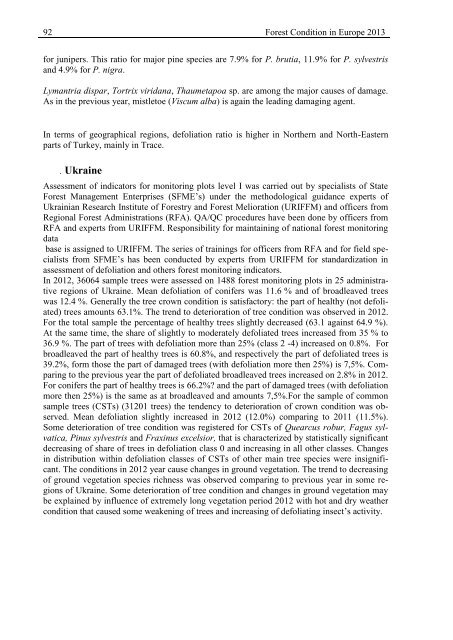Forest Condition in Europe - ICP Forests
Forest Condition in Europe - ICP Forests
Forest Condition in Europe - ICP Forests
Create successful ePaper yourself
Turn your PDF publications into a flip-book with our unique Google optimized e-Paper software.
92 <strong>Forest</strong> <strong>Condition</strong> <strong>in</strong> <strong>Europe</strong> 2013<br />
for junipers. This ratio for major p<strong>in</strong>e species are 7.9% for P. brutia, 11.9% for P. sylvestris<br />
and 4.9% for P. nigra.<br />
Lymantria dispar, Tortrix viridana, Thaumetapoa sp. are among the major causes of damage.<br />
As <strong>in</strong> the previous year, mistletoe (Viscum alba) is aga<strong>in</strong> the lead<strong>in</strong>g damag<strong>in</strong>g agent.<br />
In terms of geographical regions, defoliation ratio is higher <strong>in</strong> Northern and North-Eastern<br />
parts of Turkey, ma<strong>in</strong>ly <strong>in</strong> Trace.<br />
. Ukra<strong>in</strong>e<br />
Assessment of <strong>in</strong>dicators for monitor<strong>in</strong>g plots level I was carried out by specialists of State<br />
<strong>Forest</strong> Management Enterprises (SFME’s) under the methodological guidance experts of<br />
Ukra<strong>in</strong>ian Research Institute of <strong>Forest</strong>ry and <strong>Forest</strong> Melioration (URIFFM) and officers from<br />
Regional <strong>Forest</strong> Adm<strong>in</strong>istrations (RFA). QA/QC procedures have been done by officers from<br />
RFA and experts from URIFFM. Responsibility for ma<strong>in</strong>ta<strong>in</strong><strong>in</strong>g of national forest monitor<strong>in</strong>g<br />
data<br />
base is assigned to URIFFM. The series of tra<strong>in</strong><strong>in</strong>gs for officers from RFA and for field specialists<br />
from SFME’s has been conducted by experts from URIFFM for standardization <strong>in</strong><br />
assessment of defoliation and others forest monitor<strong>in</strong>g <strong>in</strong>dicators.<br />
In 2012, 36064 sample trees were assessed on 1488 forest monitor<strong>in</strong>g plots <strong>in</strong> 25 adm<strong>in</strong>istrative<br />
regions of Ukra<strong>in</strong>e. Mean defoliation of conifers was 11.6 % and of broadleaved trees<br />
was 12.4 %. Generally the tree crown condition is satisfactory: the part of healthy (not defoliated)<br />
trees amounts 63.1%. The trend to deterioration of tree condition was observed <strong>in</strong> 2012.<br />
For the total sample the percentage of healthy trees slightly decreased (63.1 aga<strong>in</strong>st 64.9 %).<br />
At the same time, the share of slightly to moderately defoliated trees <strong>in</strong>creased from 35 % to<br />
36.9 %. The part of trees with defoliation more than 25% (class 2 -4) <strong>in</strong>creased on 0.8%. For<br />
broadleaved the part of healthy trees is 60.8%, and respectively the part of defoliated trees is<br />
39.2%, form those the part of damaged trees (with defoliation more then 25%) is 7,5%. Compar<strong>in</strong>g<br />
to the previous year the part of defoliated broadleaved trees <strong>in</strong>creased on 2.8% <strong>in</strong> 2012.<br />
For conifers the part of healthy trees is 66.2%? and the part of damaged trees (with defoliation<br />
more then 25%) is the same as at broadleaved and amounts 7,5%.For the sample of common<br />
sample trees (CSTs) (31201 trees) the tendency to deterioration of crown condition was observed.<br />
Mean defoliation slightly <strong>in</strong>creased <strong>in</strong> 2012 (12.0%) compar<strong>in</strong>g to 2011 (11.5%).<br />
Some deterioration of tree condition was registered for CSTs of Quearcus robur, Fagus sylvatica,<br />
P<strong>in</strong>us sylvestris and Frax<strong>in</strong>us excelsior, that is characterized by statistically significant<br />
decreas<strong>in</strong>g of share of trees <strong>in</strong> defoliation class 0 and <strong>in</strong>creas<strong>in</strong>g <strong>in</strong> all other classes. Changes<br />
<strong>in</strong> distribution with<strong>in</strong> defoliation classes of CSTs of other ma<strong>in</strong> tree species were <strong>in</strong>significant.<br />
The conditions <strong>in</strong> 2012 year cause changes <strong>in</strong> ground vegetation. The trend to decreas<strong>in</strong>g<br />
of ground vegetation species richness was observed compar<strong>in</strong>g to previous year <strong>in</strong> some regions<br />
of Ukra<strong>in</strong>e. Some deterioration of tree condition and changes <strong>in</strong> ground vegetation may<br />
be expla<strong>in</strong>ed by <strong>in</strong>fluence of extremely long vegetation period 2012 with hot and dry weather<br />
condition that caused some weaken<strong>in</strong>g of trees and <strong>in</strong>creas<strong>in</strong>g of defoliat<strong>in</strong>g <strong>in</strong>sect’s activity.
















